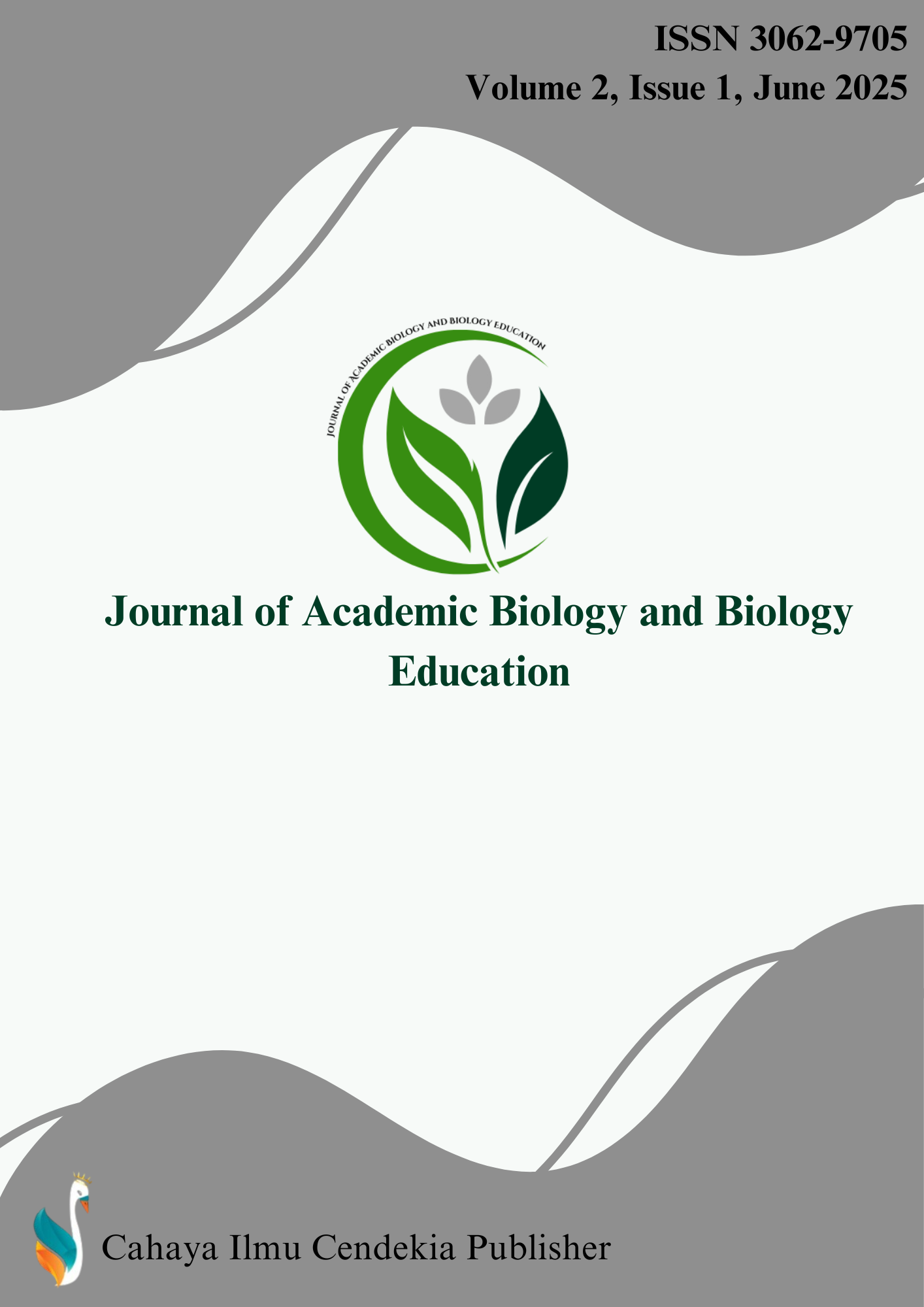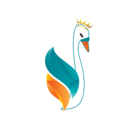Exploring the Guided Inquiry Learning Model in Biology Practicum: Its Impact on Students' Scientific Attitudes and Cognitive Knowledge
Abstract
Purpose of the study: The purpose of this study was to determine the differences in scientific attitudes and cognitive knowledge of students between guided inquiry and direct learning models in practical activities by controlling students' prior knowledge.
Methodology: This quasi-experimental study employed a Non-Equivalent Pretest-Posttest Control Group Design. From a population of 88 students, 57 were selected using purposive sampling. Instruments included multiple-choice tests and Likert scale observation sheets. Data were analyzed using Microsoft Excel and IBM SPSS 23 with One-Way MANCOVA and Partial Eta Squared for effect size.
Main Findings: The guided inquiry learning model is effective in improving students' scientific attitudes and cognitive knowledge. The average scientific attitude of students in the experimental class was 85, compared to 70 in the control class. The average post-test cognitive knowledge score was 75.17 in the experimental class and 50.93 in the control class. The One Way MANCOVA test showed significant differences between groups (p = 0.0001; partial eta squared = 0.840). Partial eta squared is a measure of effect size that indicates the proportion of variance in the dependent variables explained by the independent variable. A value of 0.840 suggests a large effect, meaning the learning model had a strong influence on students’ outcomes.
Novelty/Originality of this study: This study integrates guided inquiry learning into food testing on the digestive system topic, uniquely controlling prior knowledge to examine its impact on scientific attitudes and cognitive outcomes, thus enhancing inquiry-based learning insights.
References
J. Miranda et al., “The core components of education 4.0 in higher education: three case studies in engineering education,” Comput. Electr. Eng., vol. 93, no. June, 2021, doi: 10.1016/j.compeleceng.2021.107278.
G. J. Hwang and S. Y. Chien, “Definition, roles, and potential research issues of the metaverse in education: an artificial intelligence perspective,” Comput. Educ. Artif. Intell., vol. 3, no. May, p. 100082, 2022, doi: 10.1016/j.caeai.2022.100082.
Lukman et al., “Effective teachers’ personality in strengthening character education,” Int. J. Eval. Res. Educ., vol. 10, no. 2, pp. 512–521, 2021, doi: 10.11591/ijere.v10i2.21629.
E. N. Setiyani, Z. Hazmi, Z. Baharin, and S. N. Jesse, “The effectiveness of predict observe explain ( POE ) model with phet to improve critical thinking skills of senior high school students,” J. Educ. Technol. Learn. Creat., vol. 1, no. 2, pp. 78–87, 2023, doi: 10.37251/jetlc.v1i2.792.
C. A. Dewi, M. Erna, Martini, I. Haris, and I. N. Kundera, “Effect of contextual collaborative learning based ethnoscience to increase student’s scientific literacy ability,” J. Turkish Sci. Educ., vol. 18, no. 3, pp. 525–541, 2021, doi: 10.36681/tused.2021.88.
M. Saimon, Z. Lavicza, and T. (Noah) Dana-Picard, “Enhancing the 4Cs among college students of a communication skills course in Tanzania through a project-based learning model,” Educ. Inf. Technol., vol. 28, no. 6, pp. 6269–6285, 2023, doi: 10.1007/s10639-022-11406-9.
P. Ayyildiz and A. Yilmaz, “‘Moving the Kaleidoscope’ to see the effect of creative personality traits on creative thinking dispositions of preservice teachers: The mediating effect of creative learning environments and teachers’ creativity fostering behavior,” Think. Ski. Creat., vol. 41, p. 100879, Sep. 2021, doi: 10.1016/j.tsc.2021.100879.
F. Hardiansyah and M. Mas’odi, “The implementation of democratic character education through learning of social science materials of ethical and cultural diversity in elementary school,” J. Innov. Educ. Cult. Res., vol. 3, no. 2, pp. 234–241, 2022, doi: 10.46843/jiecr.v3i2.101.
F. Hardiansyah and Mulyadi, “Improve science learning outcomes for elementary school students through the development of flipbook media,” J. Penelit. Pendidik. IPA, vol. 8, no. 6, pp. 3069–3077, 2022, doi: 10.29303/jppipa.v8i6.2413.
M. J. Susilo and B. Kartowagiran, “Alternative curriculum model: mosque-based education integration,” J. Educ. Learn., vol. 17, no. 3, pp. 462–471, 2023, doi: 10.11591/edulearn.v17i3.20714.
A. Asman, M. Muliani, and A. Amin, “Integration of islamic values and science in integrated Islamic boarding school-based Islamic schools,” EDUSOSHUM J. Islam. Educ. Soc. Humanit., vol. 5, no. 3, pp. 313–324, 2025.
R. Hare, S. Ferguson, and Y. Tang, “Enhancing student experience and learning with iterative design in an intelligent educational game,” Br. J. Educ. Technol., no. September 2024, pp. 551–568, 2024, doi: 10.1111/bjet.13526.
A. Prabowo, D. Suryadi, D. Dasari, D. Juandi, and I. Junaedi, “Learning obstacles in the making of lesson plans by prospective mathematics teacher students,” Educ. Res. Int., vol. 2022, 2022, doi: 10.1155/2022/2896860.
B. B. Wiyono and H. H. Wu, “Increased number of scopus articles from Indonesia from 1945 to 2020, an analysis of international collaboration, and a comparison with other ASEAN Countries from 2016 to 2020,” Adm. Sci., vol. 12, no. 3, 2022, doi: 10.3390/admsci12030099.
I. N. Tika and I. G. A. T. Agustiana, “The Effect of a Blended Learning Project Based Learning Model on Scientific Attitudes and Science Learning Outcomes,” J. Ilm. Sekol. Dasar, vol. 5, no. 4, pp. 557–566, 2021, doi: 10.23887/jisd.v5i4.39869.
A. Astalini et al., “Motivation and attitude of students on physics subject in the middle school in Indonesia,” Int. Educ. Stud., vol. 12, no. 9, p. 15, 2019, doi: 10.5539/ies.v12n9p15.
O. Kumnuanek, U. Aranyawat, and P. Pongsopon, “Study of students’ moral reasoning on modern biotechnology applications using bioethics for informed decision modules,” J. Turkish Sci. Educ., vol. 19, no. 2, pp. 511–524, 2022, doi: 10.36681/tused.2022.134.
F. Almasri, G. I. Hewapathirana, F. Ghaddar, N. Lee, and B. Ibrahim, “Measuring attitudes towards biology major and non-major: Effect of students’ gender, group composition, and learning environment,” PLoS One, vol. 16, no. 5 May, pp. 1–35, 2021, doi: 10.1371/journal.pone.0251453.
L. Somerwill and U. Wehn, “How to measure the impact of citizen science on environmental attitudes, behaviour and knowledge? a review of state-of-the-art approaches,” Environ. Sci. Eur., vol. 34, no. 1, p. 18, Dec. 2022, doi: 10.1186/s12302-022-00596-1.
M. Mohzana, H. Murcahyanto, M. Fahrurrozi, and Y. N. Supriadi, “Optimization of management of laboratory facilities in the process of learning science at high school,” J. Penelit. Pendidik. IPA, vol. 9, no. 10, pp. 8226–8234, 2023, doi: 10.29303/jppipa.v9i10.5249.
M. T. Sakliressy, W. Sunarno, and F. Nurosyid, “Students scientific attitude in learning physics using problem based learning model with experimental and project methods,” J. Ilm. Pendidik. Fis. Al-Biruni, vol. 10, no. 1, pp. 59–70, 2021, doi: 10.24042/jipfalbiruni.v10i1.8347.
D. P. Lestari, Supahar, Paidi, Suwarjo, and Herianto, “Effect of science virtual laboratory combination with demonstration methods on lower-secondary school students’ scientific literacy ability in a science course,” Educ. Inf. Technol., vol. 28, no. 12, pp. 16153–16175, 2023, doi: 10.1007/s10639-023-11857-8.
S. Korucu-Kış, “Preparing student teachers for real classrooms through virtual vicarious experiences of critical incidents during remote practicum: A meaningful-experiential learning perspective,” Educ. Inf. Technol., vol. 26, no. 6, pp. 6949–6971, 2021, doi: 10.1007/s10639-021-10555-7.
J. Firmansyah, W. Widiasih, H. Saputra, D. Phon Kamilah, and V. Ginting, “The effectiveness of project online collaboration laboratory in improving science process and critical thinking skills,” J. Pendidik. MIPA, vol. 25, no. 2, pp. 827–846, 2024, doi: 10.23960/jpmipa/v25i2.pp827-846.
B. Wu, X. Peng, and Y. Hu, “How to foster pre-service teachers’ STEM learning design expertise through virtual internship: a design-based research,” Educ. Technol. Res. Dev., vol. 69, no. 6, pp. 3307–3329, 2021, doi: 10.1007/s11423-021-10063-y.
A. Prianto, U. N. Qomariyah, and Firman, “Does student involvement in practical learning strengthen deeper learning competencies?,” Int. J. Learn. Teach. Educ. Res., vol. 21, no. 2, pp. 211–231, 2022, doi: 10.26803/ijlter.21.2.12.
D. Efendi et al., “The effect of virtual reality on cognitive, affective, and psychomotor outcomes in nursing staffs: systematic review and meta-analysis,” BMC Nurs., vol. 22, no. 1, pp. 1–15, 2023, doi: 10.1186/s12912-023-01312-x.
H. J. Yun and J. Cho, “Affective domain studies of K-12 computing education: a systematic review from a perspective on affective objectives,” J. Comput. Educ., vol. 9, no. 3, pp. 477–514, 2022, doi: 10.1007/s40692-021-00211-x.
Z. Zen, Reflianto, Syamsuar, and F. Ariani, “Academic achievement: the effect of project-based online learning method and student engagement,” Heliyon, vol. 8, no. 11, 2022, doi: 10.1016/j.heliyon.2022.e11509.
J. Kareem, R. S. Thomas, and V. S. Nandini, “A conceptual model of teaching efficacy and beliefs, teaching outcome expectancy, student technology use, student engagement, and 21st-century learning attitudes: a STEM education study,” Interdiscip. J. Environ. Sci. Educ., vol. 18, no. 4, p. e2282, 2022, doi: 10.21601/ijese/12025.
I. V. Rossi, J. D. de Lima, B. Sabatke, M. A. F. Nunes, G. E. Ramirez, and M. I. Ramirez, “Active learning tools improve the learning outcomes, scientific attitude, and critical thinking in higher education: E experiences in an online course during the COVID-19 pandemic,” Biochem. Mol. Biol. Educ., vol. 49, no. 6, pp. 888–903, 2021, doi: 10.1002/bmb.21574.
R. Rahayu, S. Siswanto, C. A. Ramadhanti, and B. Subali, “Guided Inquiry Learning Model Using Scientific Argumentation Activities to Improve Concept Understanding on Optical and Light,” J. Pendidik. Fis. Indones., vol. 19, no. 1, pp. 55–64, 2023, doi: 10.15294/jpfi.v19i1.36626.
A. Juniar and D. I. Simbolon, “Effects of guided inquiry learning models in improving students’ scientific process skills and learning outcomes for thermochemical materials,” 9th Annu. Int. Semin. Trends Sci. Sci. Educ. 2022, vol. 0, pp. 313–320, 2023, doi: 10.2478/9788367405195-043.
Hasmawati, M. S. Ali, and M. Arsyad, “Influence of the guided inquiry learning model and scientific attitude in physics on students’ science process skills,” J. Penelit. Pendidik. IPA, vol. 9, no. 12, pp. 11484–11496, 2023, doi: 10.29303/jppipa.v9i12.4729.
N. J. Hunsu, O. O. Adesope, and S. R. Yli-Piipari, “A path model analysis of preform students’ factors and comprehension strategies on cognitive learning outcomes associated with text comprehension,” Front. Educ., vol. 9, no. April, 2024, doi: 10.3389/feduc.2024.1239261.
K. P. Jayalath and H. K. T. Ng, “A graphical alternative for multiple group comparisons in analysis of covariance,” Appl. Stoch. Model. Bus. Ind., vol. 38, no. 6, pp. 1172–1195, Nov. 2022, doi: 10.1002/asmb.2706.
G. Vallejo, M. P. Fernández, and P. E. Livacic-Rojas, “Multivariate analysis of covariance for heterogeneous and incomplete data.,” Psychol. Methods, vol. 29, no. 4, pp. 731–747, Aug. 2024, doi: 10.1037/met0000558.
M. Senisum, H. Susilo, H. Suwono, and Ibrohim, “GIReSiMCo: A learning model to scaffold students’ science process skills and biology cognitive learning outcomes,” Educ. Sci., vol. 12, no. 4, 2022, doi: 10.3390/educsci12040228.
J. Kang, “Interrelationship between inquiry-based learning and instructional quality in predicting science literacy,” Res. Sci. Educ., vol. 52, no. 1, pp. 339–355, 2022, doi: 10.1007/s11165-020-09946-6.
R. B. Toma, I. Yánez-Pérez, and J. Á. Meneses-Villagrá, “Measuring self-efficacy beliefs in teaching inquiry-based science and the nature of scientific inquiry,” Sci. Educ., no. 0123456789, 2024, doi: 10.1007/s11191-024-00553-9.
Copyright (c) 2025 Fetmirwati Fetmirwati, Luiz Gustavo Franco, Maria Theresa G. Tadena

This work is licensed under a Creative Commons Attribution 4.0 International License.
Authors who publish with this journal agree to the following terms:
- Authors retain copyright and acknowledge that the Journal of Academic Biology and Biology Education is the first publisher licensed under a Creative Commons Attribution 4.0 International License.
- Authors are able to enter into separate, additional contractual arrangements for the non-exclusive distribution of the journal's published version of the work (e.g., post it to an institutional repository or publish it in a book), with an acknowledgment of its initial publication in this journal.
- Authors are permitted and encouraged to post their work online (e.g., in institutional repositories or on their website) prior to and during the submission process, as it can lead to productive exchanges and earlier and greater citation of published work.



.png)

.png)
.png)








